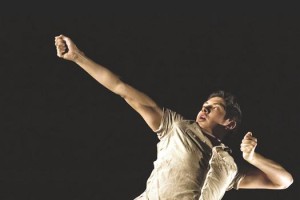I’m Not The Indian You Have in Mind explores stereotypes of First Nations peoples through dance at Toronto’s Harbourfront Centre
I’m Not The Indian You Have In Mind, playing at Harbourfront, is a dance show produced by Native Women in the Arts inspired by Thomas King’s short film I’m Not The Indian You Had In Mind. It doesn’t tell the same story, however, and at times it was hard for me to understand the connection at all. The dancing is lively and lovely, and there’s a lot of humour and good moments, but no cohesive thread throughout the piece.
King’s film tackles historically bred stereotypes of First Nations peoples, then describes the realities of Native people today, then talks about the environmental devastation of the post-colonial world, and then wonders, rather cheerfully, if they have been so co-opted into the prevalent culture as to be part of the problem.
The dance production starts off with the stereotypes presented via a series of gestures set to a soundtrack of street noises. After that I couldn’t discern any alignment with the film.
The dance numbers themselves were great. Two of the pieces were very high energy, the music accentuated by the dancers stomping and clapping and slapping their bodies. They would fall in and out of rhythm with each other, sometimes stopping for a moment of stillness, sometimes picking up a syncopated beat. During one number they would occasionally freeze, putting on big plastic smiles. It was like a delightful cartoon with a dark undercurrent.
One piece, played on the upper deck of gorgeous Enwave theatre, wasn’t subtle at all about its darkness. Wearing headdresses that created wings, reminiscent of angels – or demons – as much as of traditional First Nations headdresses, two of the male dancers enacted what seemed to be an elaborate ritual death scene. The soundscape for this was sinister, and seemed to recall an ancient time when monsters roamed the earth. The effect was haunting.
I saved the best to talk about last – there was a Lucha Libre fight scene! Two of the dancers, one of whom was also the choreographer Carlos Rivera, are Indigenous people from Mexico, so this homage was appropriate as well as entertaining. Apart from the humour inherent in Lucha Libre, this allowed for some spectacular displays of strength and physical control as well as the visual joke of pitting a very tiny woman against a very tall man. This comedy was also tinged with darkness – Lucha Libre is violence, as much as it is kitsch.
Both my companion and I wished there were more of a narrative thread. The scenes didn’t seem to connect to each other to tell a particular story, as engaging as they were individually. This disjointed effect was exacerbated by the inclusion of one Caucasian dancer. Carlos Rivera, the choreographer/dancer, was questioned about this at the Q&A afterward and said that it was to represent the diversity of Toronto. Given that there were five Indigenous dancers and one white one, it came off as some sort of strange reverse tokenism. I suspect they just like working together, since the program indicates they have prior experience with each other. She was certainly a very strong dancer, it just created a visual dissonance on stage, particularly when she was enacting stereotypes of First Nations people.
Overall the show is very enjoyable, and would likely be more so if you go in without any expectations of it having a narrative, or relevance to the film.
Details
- I’m Not The Indian You Have In Mind is playing till October 13, 2012 at the Enwave theatre and Harbourfront, (231 Queens Quay West)
- Shows run Thursday, Friday, and Saturday at 8 p.m.
- Tickets $15 for students, $20 for Seniors and $28 Regular.
- Tickets are available online, at 416-973-4000 or in person at the Box Office.
Photo of Waawaate Fobister by Andrea Keijzer

